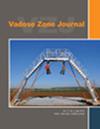Soil carbon determination for long-term monitoring revisited using thermo-gravimetric analysis
IF 2.8
3区 地球科学
Q3 ENVIRONMENTAL SCIENCES
引用次数: 0
Abstract
Soils and the vadose zone are the major terrestrial repository of carbon (C) in the form of soil organic matter (SOM), more resistant black carbon (BC), and inorganic carbonate. Differentiating between these pools is important for assessing vulnerability to degradation and changes in the C cycle affecting soil health and climate regulation. Major monitoring programs from field to continent are now being undertaken to track changes in soil carbon (SC). Inexpensive, robust measures that can differentiate small changes in the C pools in a single measurement are highly desirable for long-term monitoring. In this study, we assess the accuracy and precision of thermo-gravimetric analysis (TGA) using organic matter standards, clay minerals, and soils from a national data set. We investigate the use of TGA to routinely differentiate between C pools, something no single measurement has yet achieved. Based on the kinetic nature of thermal oxidation of SC combined with the different thermodynamic stabilities of the molecules, we designed a new method to quantify the inorganic and organic SC and further separate the organic biogeochemically active SOM (as loss on ignition, LOI) from the resistant BC in soils. We analyze the TGA spectrums of a national soil monitoring data set (n = 456) and measure total carbon (TC) using thermal oxidation and also demonstrate a TC/LOI relationship of 0.55 for soils ranging from mineral soils to peat for the United Kingdom consistent with previous monitoring campaigns.利用热重分析重新审视用于长期监测的土壤碳测定方法
土壤和渗流带是陆地碳(C)的主要储存库,其形式包括土壤有机质(SOM)、抗性更强的黑碳(BC)和无机碳酸盐。区分这些碳库对于评估影响土壤健康和气候调节的土壤退化和碳循环变化的脆弱性非常重要。目前,从田野到大陆都在开展大型监测计划,以跟踪土壤碳(SC)的变化。对于长期监测而言,成本低廉、可靠且能在一次测量中区分碳库微小变化的测量方法是非常可取的。在本研究中,我们利用国家数据集中的有机物标准、粘土矿物和土壤,对热重分析(TGA)的准确性和精确度进行了评估。我们研究了如何利用热重分析对不同的碳库进行常规区分,目前还没有任何一种测量方法可以实现这一点。基于SC热氧化的动力学性质以及分子的不同热力学稳定性,我们设计了一种新方法来量化无机和有机SC,并进一步将土壤中具有生物地球化学活性的有机SOM(作为点火损失率,LOI)与具有抗性的BC分离开来。我们分析了全国土壤监测数据集(n = 456)的 TGA 光谱,并使用热氧化法测量了总碳 (TC),还证明了英国从矿质土壤到泥炭土的 TC/LOI 关系为 0.55,这与之前的监测活动一致。
本文章由计算机程序翻译,如有差异,请以英文原文为准。
求助全文
约1分钟内获得全文
求助全文
来源期刊

Vadose Zone Journal
环境科学-环境科学
CiteScore
5.60
自引率
7.10%
发文量
61
审稿时长
3.8 months
期刊介绍:
Vadose Zone Journal is a unique publication outlet for interdisciplinary research and assessment of the vadose zone, the portion of the Critical Zone that comprises the Earth’s critical living surface down to groundwater. It is a peer-reviewed, international journal publishing reviews, original research, and special sections across a wide range of disciplines. Vadose Zone Journal reports fundamental and applied research from disciplinary and multidisciplinary investigations, including assessment and policy analyses, of the mostly unsaturated zone between the soil surface and the groundwater table. The goal is to disseminate information to facilitate science-based decision-making and sustainable management of the vadose zone. Examples of topic areas suitable for VZJ are variably saturated fluid flow, heat and solute transport in granular and fractured media, flow processes in the capillary fringe at or near the water table, water table management, regional and global climate change impacts on the vadose zone, carbon sequestration, design and performance of waste disposal facilities, long-term stewardship of contaminated sites in the vadose zone, biogeochemical transformation processes, microbial processes in shallow and deep formations, bioremediation, and the fate and transport of radionuclides, inorganic and organic chemicals, colloids, viruses, and microorganisms. Articles in VZJ also address yet-to-be-resolved issues, such as how to quantify heterogeneity of subsurface processes and properties, and how to couple physical, chemical, and biological processes across a range of spatial scales from the molecular to the global.
 求助内容:
求助内容: 应助结果提醒方式:
应助结果提醒方式:


